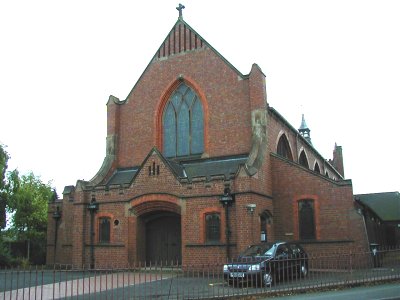|
The Third
and Final Church
The idea of building a larger,
separate church had been around since the mid 1890s. In
fact the piece of land that had been used for the school
extension, had originally been sought for the building
of a new church. The school now occupied most of the
piece of land in between Hilton Street and Water Street,
and so a new church would have to be built elsewhere. |
|

St. Stephen's Church. |
In 1906 an anonymous friend of St. Mary’s Church
promised to donate £1,000 towards the cost of a new
church at Springfield, estimated at £5,000, providing
that £3,000 could be raised towards the building cost,
and that building work could begin by the spring of
1907. This was too good an offer to miss, and by May
1907 the Rev. W. Collett of St. Mary’s announced that he
could raise around £700 through promises and
subscriptions. |
|
The Springfield congregation
promised to raise 4,000 “self-denial shillings”,
amounting to £200, and the Rev. Collett issued a printed
appeal to the 4,500 inhabitants of Springfield, reading
as follows:
St. Stephen’s Church Building
Scheme is at last within measurable distance, about £700
being the amount now required to commence building. The
congregation of St. Stephen’s has undertaken to raise in
Springfield at least £200 towards the £700 required.
Remember the church will be the
common property of every man, woman, and child in
Springfield.
If ours is a comparatively poor
locality, then ours also is the opportunity of laying
the foundation of our church securely, in the spirit of
self sacrifice for Christ’s sake.
We cordially invite you to join
us and to give us as many shillings as you can afford.
|
|
The appeal was successful, and a
suitable piece of land was acquired on the eastern side
of Hilton Street, opposite the school. The ceremony for
the cutting of the first sod took place on 8th
September, 1907 when Mrs. Collett and master Chris
Tunnadine assisted in the proceedings. The foundation
stone was laid on 30th November by the Earl
of Harrowby, and the anonymous donor remained true to
his word. He donated £1,000 even though the project had
already overrun by 6 months.
Work on the new church progressed
rapidly. The building, designed by F. T. Beck and built
by H. Willcock & Son had been completed by September
1908 at a cost of £5,200. The Clerk of Works was Mr.
Drake. By the time of completion £4,400 had been raised
towards the cost of the building, and many of the
internal fittings and books were given as gifts,
including the alter, the pulpit, the font, the communion
rails, the alter candlesticks, and the service and
prayer books. |

Another view of the church. |
|
The new building was described in
the Express & Star as follows:
The building is of brick, and in
the interior work for the pillars and other points,
Alveley stone has been used. The nave is extremely
imposing and the chancel large. In the baptistery, a
handsome font, the basin of green stone, supported by
alabaster pillars, compels attention. The church will
seat upwards of 700 people. In the nave alone there is
accommodation for 552.
The church was consecrated on
Tuesday 22nd September, 1908 in the presence
of the Bishop of Lichfield; Archdeacon Hodgson; the Rev.
Collett; the Rector of Wolverhampton, the Rev. A. Penny;
and church organist John Minshall. The streets were
lined with flags and bunting and the large number of
parishioners and visitors who attended the event also
viewed a tree planting ceremony before the service,
during which five lime trees were planted by the vicar,
the 2 churchwardens, the Rev. Hugh H. Tunnadine, and Mr.
Drake. The bishop planted several saplings during a
second tree planting ceremony that took place after the
service.

From the 1908 Wolverhampton Red
Book.
|
 |
|
 |
|
 |
Return to
the
2nd church |
|
Return to
the
beginning |
|
Proceed to the
early years |
|